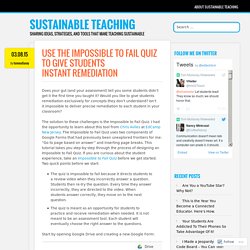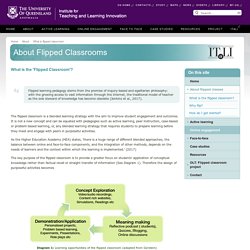

Use the Impossible to Fail Quiz to Give Students Instant Remediation. Does your gut (and your assessment) tell you some students didn’t get it the first time you taught it?

Would you like to give students remediation exclusively for concepts they don’t understand? Isn’t it impossible to deliver precise remediation to each student in your classroom? The solution to these challenges is the Impossible to Fail Quiz. I had the opportunity to learn about this tool from Chris Aviles at EdCamp New Jersey. The Impossible to Fail Quiz uses two components of Google Forms that had previously been unexplored frontiers for me: “Go to page based on answer” and inserting page breaks. The quiz is impossible to fail because it directs students to a review video when they incorrectly answer a question. Start by opening Google Drive and creating a new Google Form: Follow the pattern of adding a page break and a question for as many questions as you want. September EdTechTeam Teacher Leader Cohort - Community.
Use the Impossible to Fail Quiz to Give Students Instant Remediation. Flipping The Classroom… A Goldmine of Research and Resources To Keep You On Your Feet. Greetings from Boston and BLC12 (Alan November’s Building Learning Communities Conference ).

If you wish to follow the happenings at BLC12 check out the hashtag #BLC12 on Twitter. Welcome to another post rich in resources on the Flipped Classroom. If you have come here looking for links that will guide you to videos and multimedia to use in a Flipped Classroom you will find that in the second half of this post. Perhaps you have tried a little Flip of your own and want to learn more. If you are beginning to investigate what a Flipped Classroom is, with the thought of possibly trying some kind of Flip yourself… then this is also the right place. Quick Note – I have been getting a lot of request asking if I will make a visit to your school, organization, or conference.
Introduction To The Flip Many educators are beginning to become aware of the growing teaching method referred to as “Flipping The Classroom”. Resources To Better Understand Flipping the Classroom Resources Research Like this: Khanacademy. ELI7081. Flipped Classroom. Khan Academy: My Final Remarks. Many people aren’t getting the nuances of my recent Khan Academy arguments.

I’ll make my final remarks and then put this thread to rest. Khan Academy videos are nothing new. MIT OpenCourseWare has been around for TEN YEARS now. Walter Lewin’s awesome physics lectures have been available for most of those 10 years — despite the fact they are pseudoteaching, and his students emerged with no greater understanding of physics than those of professors before him. And I didn’t have a problem with Khan Academy (as a collection of videos) until very recently. For me, the problem is the way Khan Academy is being promoted. (c) tcoffey (via Flickr) If your philosophy of education is sit-and-get, i.e., teaching is telling and learning is listening, then Khan Academy is way more efficient than classroom lecturing.
But TRUE progressive educators, TRUE education visionaries and revolutionaries don’t want to do these things better. Watch one Modeling class in action: Feedback I would find WAY MORE useful: The Flipped Classroom Model: A Full Picture. Due to Khan Academy’s popularity, the idea of the flipped classroom has gained press and credibility within education circles. Briefly, the Flipped Classroom as described by Jonathan Martin is: Flip your instruction so that students watch and listen to your lectures… for homework, and then use your precious class-time for what previously, often, was done in homework: tackling difficult problems, working in groups, researching, collaborating, crafting and creating. Classrooms become laboratories or studios, and yet content delivery is preserved. Flip your instruction so that students watch and listen to your lectures… for homework, and then use your precious class-time for what previously, often, was done in homework: tackling difficult problems, working in groups, researching, collaborating, crafting and creating.
Classrooms become laboratories or studios, and yet content delivery is preserved ( Flipping The Classroom… A Goldmine of Research and Resources To Keep You On Your Feet. What is flipped classroom. What is the 'Flipped Classroom'?

Flipped learning pedagogy stems from the premise of inquiry-based and egalitarian philosophy: with the growing access to vast information through the internet, the traditional model of teacher as the sole steward of knowledge has become obsolete (Jenkins et al., 2017). The flipped classroom is a blended learning strategy with the aim to improve student engagement and outcomes. It is not a new concept and can be equated with pedagogies such as active learning, peer instruction, case-based or problem-based learning, or, any blended learning strategy that requires students to prepare learning before they meet and engage with peers in purposeful activities. As the Higher Education Academy (HEA) states, 'there is a huge range of different blended approaches; the balance between online and face-to-face components, and the integration of other methods, depends on the needs of learners and the context within which the learning is implemented.' (2017)